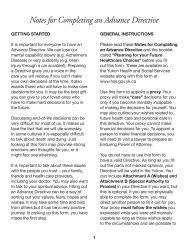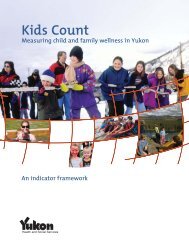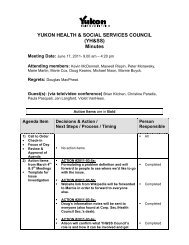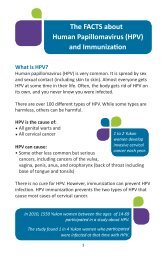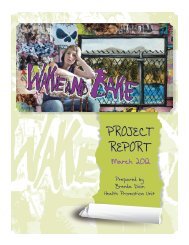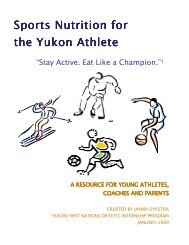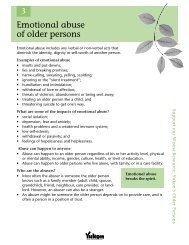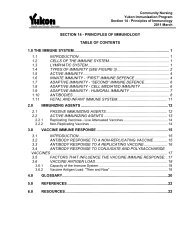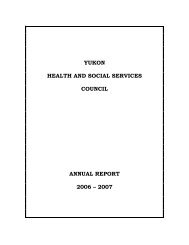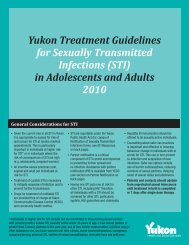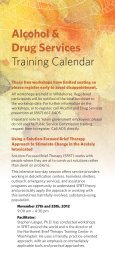An educational planning tool (LEIC) for learners with FASD
An educational planning tool (LEIC) for learners with FASD
An educational planning tool (LEIC) for learners with FASD
You also want an ePaper? Increase the reach of your titles
YUMPU automatically turns print PDFs into web optimized ePapers that Google loves.
<strong>An</strong> Educational Planning<br />
Tool (<strong>LEIC</strong>) <strong>for</strong> Learners<br />
<strong>with</strong> <strong>FASD</strong><br />
September 29, 2010<br />
Whitehorse, Y.T.<br />
Kathi Hughes and<br />
Stacey Wakabayashi
Purpose<br />
• To explain a <strong>planning</strong> <strong>tool</strong>, <strong>LEIC</strong> (Learner,<br />
Environment, Instruction, Curriculum), <strong>for</strong><br />
<strong>learners</strong> <strong>with</strong> complex needs<br />
• To share our research project that combined<br />
the <strong>planning</strong> <strong>tool</strong> and teacher mentoring<br />
• To share resources
Agenda<br />
• Introductions / <strong>FASD</strong> Overview 10:30-10:50<br />
• <strong>LEIC</strong> Planning Tool 10:50-11:15<br />
• <strong>LEIC</strong> case study 11:15-11:30<br />
• Research 11:30-11:45<br />
• Questions / Resources 11:45-12:00
Fetal Alcohol Spectrum Disorder<br />
<strong>FASD</strong> describes a<br />
spectrum of disorders<br />
caused by prenatal<br />
exposure to alcohol.
<strong>FASD</strong>: Diagnostic categories<br />
Fetal Alcohol Syndrome
adapted from: http://www.cerebralpalsychildren.com/CPFetal.html
Shift in Thinking<br />
• View <strong>FASD</strong> as a physical disability<br />
• IS problem to HAS problem<br />
• Won’t to Can’t<br />
• Non-compliance to non-competence
<strong>LEIC</strong><br />
(adapted from Dr. Carl <strong>An</strong>serello’s “ICEL”)<br />
• L earner (strengths, needs, primary disabilities,<br />
secondary behaviours, expectations of setting/brain)<br />
*Poor fit?<br />
• E nvironment (set up of classroom, sensory issues)<br />
• I nstruction / Communication (teaching and<br />
communicating strategies/accommodations)<br />
• C urriculum / Resources<br />
(adaptations/strategies/accommodations, etc)
Where is this learner at?<br />
What are his/her strengths?<br />
Sensory<br />
seeking?<br />
Avoiding?<br />
Learning style?<br />
Interests?<br />
Other pertinent info?
Tony <strong>LEIC</strong> Wheel
Every Brain is Different
Primary Disability<br />
A functional deficit<br />
that is the result of<br />
permanent brain<br />
injury.
Primary Disabilities<br />
• Impulsivity<br />
• Linking actions to<br />
outcomes<br />
• Predicting outcomes<br />
• Generalizing in<strong>for</strong>mation<br />
• Abstracting<br />
• Staying still<br />
• Paying attention<br />
• Memory<br />
• Processing pace<br />
• Sequencing<br />
• Over stimulation<br />
• Sensory issues<br />
• Perseveration<br />
• Language<br />
• Dysmaturity or<br />
“uneven maturation”
Poor Fit?<br />
Expectations in the<br />
Environment<br />
Requirements of<br />
your brain<br />
Possible Primary<br />
Disabilities<br />
- give a quick<br />
response<br />
- process quickly<br />
- slow processing<br />
- provide a<br />
related,<br />
descriptive<br />
sentence<br />
- remember,<br />
utilize prior<br />
in<strong>for</strong>mation,<br />
<strong>for</strong>mulate<br />
- memory<br />
difficulties
“Secondary Disabilities” /<br />
Behaviours<br />
• The feelings / behaviours that develop<br />
over time when the primary disabilities<br />
are not supported (Streissguth, 1996)but….might<br />
be other manifestations of the primary<br />
brain alterations (Clarren, 2009)
Secondary<br />
Disabilities / Behaviours<br />
• Frustration<br />
• <strong>An</strong>xiety<br />
• Shutdown<br />
• <strong>An</strong>ger<br />
• Fatigue<br />
• Isolation<br />
• Poor self esteem<br />
• Depression<br />
• School problems<br />
• Trouble <strong>with</strong> law<br />
• Drug and alcohol issues<br />
• Independent living<br />
challenges<br />
• Mental health issues<br />
• Parenting difficulties
What are we<br />
expecting of this<br />
leaner?<br />
VS<br />
What does this<br />
student have<br />
difficulties <strong>with</strong>?<br />
What are we seeing in<br />
the classroom?
Accommodations<br />
- creating a “good fit”<br />
• Strategies and/or<br />
adaptations that address<br />
the brain disability and<br />
reduce the likelihood of<br />
secondary disabilities<br />
• Accommodations based<br />
on the unique profile of<br />
each learner
Accommodations - Good Fit<br />
Environment Instruction Curriculum
Case Study-group work<br />
• Listen to description of learner<br />
• Use <strong>LEIC</strong> sheet to create accommodations<br />
to support 1 or 2 of the primary disabilities<br />
• Utilize student’s strengths, interests, and<br />
learning style<br />
• Use Guiding Questions <strong>for</strong> help
IEPs<br />
<strong>LEIC</strong> Accommodations
Victoria Foundation<br />
Research Project<br />
• UNBC/SD57/UBC/POP<strong>FASD</strong>/VF<br />
• 6 primary teachers/ 8 students<br />
• 2 day training<br />
• Classroom visits - weekly<br />
• Team <strong>planning</strong> meeting using <strong>LEIC</strong><br />
• Support to teachers implementing<br />
accommodations
Value of the Intervention to Teachers<br />
“Every time I learned new things that I<br />
can incorporate. Even just raising the<br />
level of understanding, how can I make<br />
this better and how can I help this kid.”
Timing of the Intervention<br />
“This way you’re constantly improving<br />
throughout the year because there’s the<br />
next meeting and the next meeting and<br />
something else is being brought <strong>for</strong>ward<br />
and plenty of time to share <strong>with</strong> the<br />
other people that are there.”
Impact on Teaching Practice<br />
“It made me change the way I was<br />
looking at that child and their behaviour.<br />
It just shed a totally different light.”
Summary<br />
• Use <strong>LEIC</strong> Planning Tool to guide<br />
solution finding <strong>for</strong> individual <strong>learners</strong><br />
• Involve all team members in the<br />
<strong>planning</strong> meetings<br />
• Encourage a strengths-based approach<br />
• Support the classroom teachers by<br />
assisting <strong>with</strong> the implementation of<br />
accommodations
Final Thoughts<br />
• Every brain is different so…<br />
“Try differently rather than<br />
harder” (Malbin)<br />
• “Every day is a new day” (<strong>An</strong>on)
Thank you<br />
POP<strong>FASD</strong> Office<br />
250-564-6574<br />
www.fasdoutreach.ca


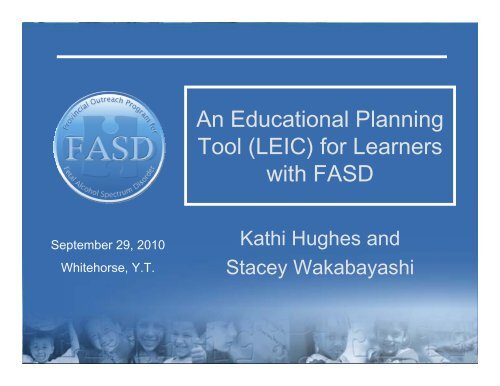
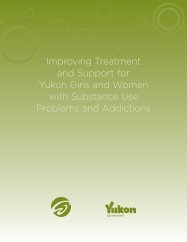
![Women and Alcohol: A women's health resource [2326.26 KB ]](https://img.yumpu.com/22340649/1/190x245/women-and-alcohol-a-womens-health-resource-232626-kb-.jpg?quality=85)
